Modeling and Experimental Study of the Dual Cylinder Fluid Inerter
Abstract
:1. Introduction
2. Structure and Principle of the Dual-Cylinder Fluid Inerter
2.1. Structure and Working Principle
2.2. Condition of Free Motion
3. Modeling of Mechanical Properties of a Dual-Cylinder Fluid Inerter
3.1. Modeling of Inertia Forces
3.2. Damping Force Modeling
3.3. Simulation of Mechanical Properties
4. Comparative Study with Single-Cylinder Fluid Inerter
5. Bench Test
6. Conclusions
Author Contributions
Funding
Institutional Review Board Statement
Informed Consent Statement
Data Availability Statement
Conflicts of Interest
References
- Smith, M.C. Synthesis of mechanical networks: The inerter. IEEE Trans. Autom. Control 2002, 47, 1648–1662. [Google Scholar] [CrossRef] [Green Version]
- Shen, Y.; Chen, L.; Liu, Y. Analysis of vibration isolation performance of vehicle suspension with nonlinear fluid inerter. Automot. Eng. 2017, 39, 789–795. [Google Scholar]
- Du, F.; Mao, M.; Chen, Y. Structure design and performance analysis of inerter-spring-damper suspension based on dynamic model and parameter optimization. J. Vib. Shock 2014, 33, 59–65. [Google Scholar]
- Lazar, I.F.; Neild, S.A.; Wagg, D.J. Using an inerter-based device for structural vibration suppression. Earthq. Eng. Struct. Dyn. 2014, 43, 1129–1147. [Google Scholar] [CrossRef] [Green Version]
- Giaralis, A.; Petrini, F. Wind-induced vibration mitigation in tall buildings using the tuned mass-damper-inerter. J. Struct. Eng. 2017, 143, 04017127. [Google Scholar] [CrossRef]
- Wen, H.; Guo, J. Performance Analysis of Habitual Capacity Vibration Isolation System and Exploration of Its Application in Ship-Sea Field; National Defence Industry Press: Beijing, China, 2018; pp. 1–20. [Google Scholar]
- Lazar, I.F.; Neild, S.A.; Wagg, D.J. Vibration suppression of cables using tuned inerter dampers. Eng. Struct. 2016, 122, 62–71. [Google Scholar] [CrossRef] [Green Version]
- Xu, K.; Bi, K.; Han, Q. Using tuned mass damper inerter to mitigate vortex-induced vibration of long-span bridges: Analytical study. Eng. Struct. 2019, 182, 101–111. [Google Scholar] [CrossRef]
- Jiang, J.Z.; Matamoros-Sanchez, A.Z.; Goodall, R.M.; Smith, M.C. Passive suspensions incorporating inerters for railway vehicles. Veh. Syst. Dyn. 2012, 50 (Suppl. S1), 263–276. [Google Scholar] [CrossRef]
- Li, Y.; Jiang, J.Z.; Neild, S. Inerter -based configurations for main-landing-gear shimmy suppression. J. Aircr. 2016, 54, 684–693. [Google Scholar] [CrossRef] [Green Version]
- Robin, T. Fluid Inerter: EP. EP2528757A1, 5 December 2012. [Google Scholar]
- Swift, S.J.; Smith, M.C.; Glover, A.R. Design and modelling of a fluid inerter. Int. J. Control 2013, 86, 2035–2051. [Google Scholar] [CrossRef]
- Deastra, P.; Wagg, D.J.; Sims, N.D. The realisation of an inerter-based system using fluid inerter. In Dynamics of Civil Structures; Springer: Cham, Switzerland, 2019; Volume 2, pp. 127–134. [Google Scholar]
- Tipuric, M.; Deastra, P.; Wagg, D. Semi-active inerters using magnetorheological fluid: A feasibility study. In Active & Passive Smart Structures & Integrated Systems XII, Proceedings of the SPIE Smart Structures and Materials + Nondestructive Evaluation and Health Monitoring, Denver, CO, USA, 4–8 March 2018; SPIE: Bellingham, WA, USA, 2018. [Google Scholar]
- Liu, X. Fluid Inerter Based Vibration Suppression: Modelling Methodology. Ph.D. Thesis, University of Bristol, Bristol, UK, 2019. [Google Scholar]
- Wang, L.; Mao, M.; Lei, Q.; Chen, Y.; Zhang, X. Modeling and testing for a hydraulic inerter. J. Vib. Shock 2018, 37, 146–152. [Google Scholar]
- Shen, Y.; Liu, Y.; Chen, L. Optimal design and experimental research of vehicle suspension based on a hydraulic electric inerter. Mechatronics 2019, 61, 12–19. [Google Scholar] [CrossRef]
- Du, F.; Yang, Y.; Wang, Y. Dual Cylinder Fluid Inerter. CN113719572A, 30 November 2021. [Google Scholar]
- Wu, W. Fluid Mechanics; Peking University Press: Beijing, China, 2018. [Google Scholar]
- Dixon, J.C. The Shock Absorbe Handbook; Professional Engineering Publishing Ltd.: London, UK; John Wiley & Sons Ltd.: Chichester, UK, 2007. [Google Scholar]
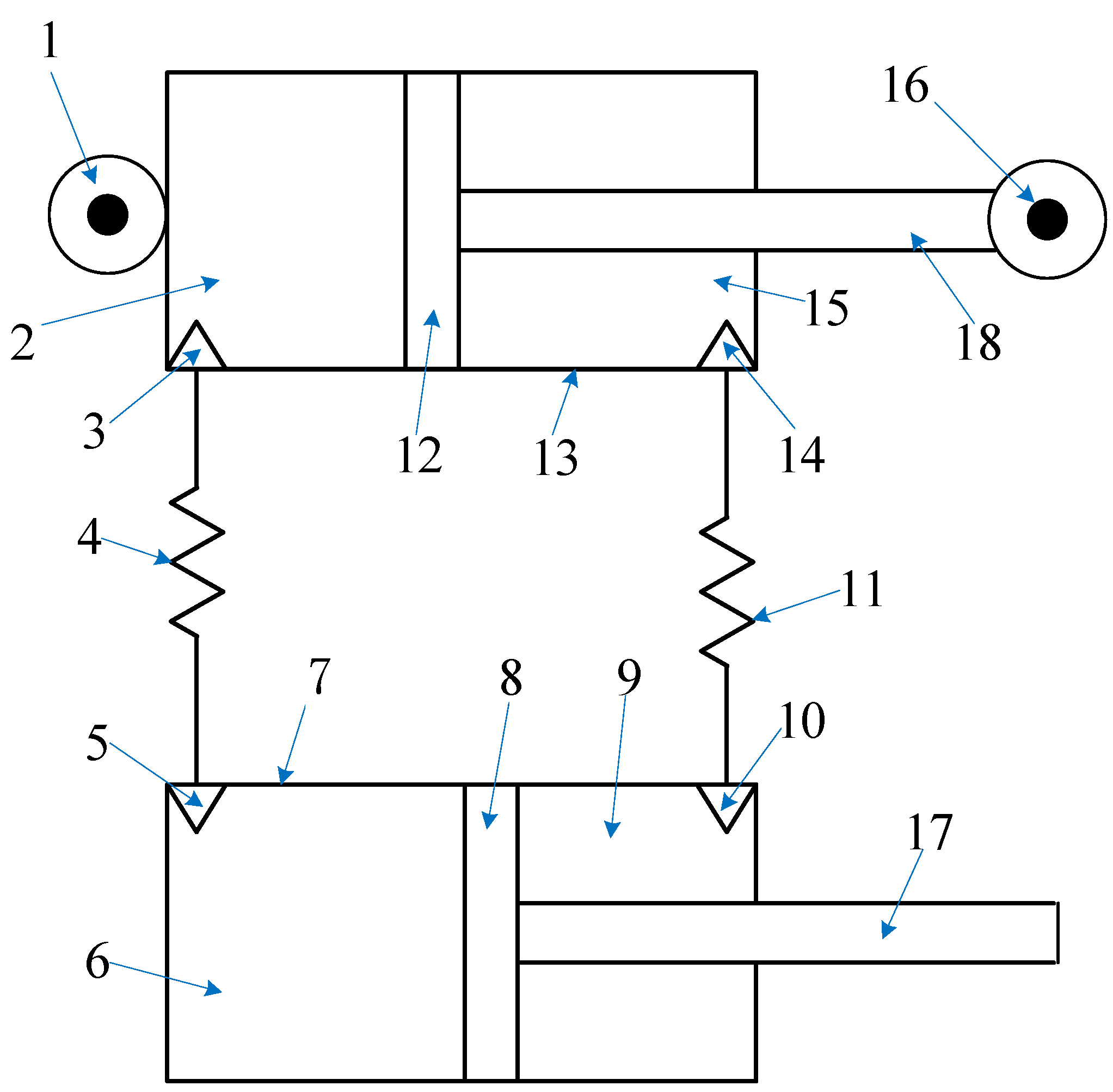


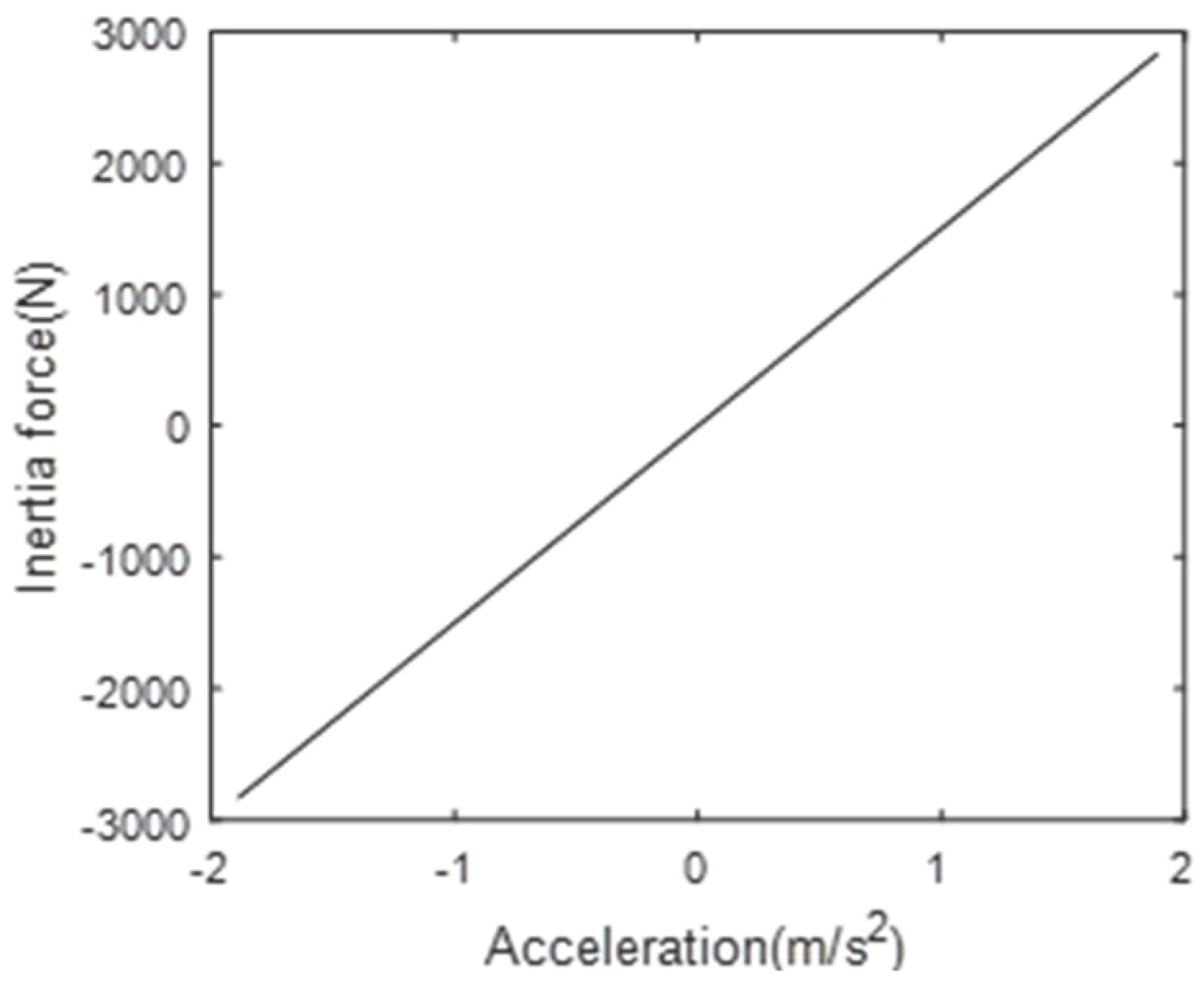
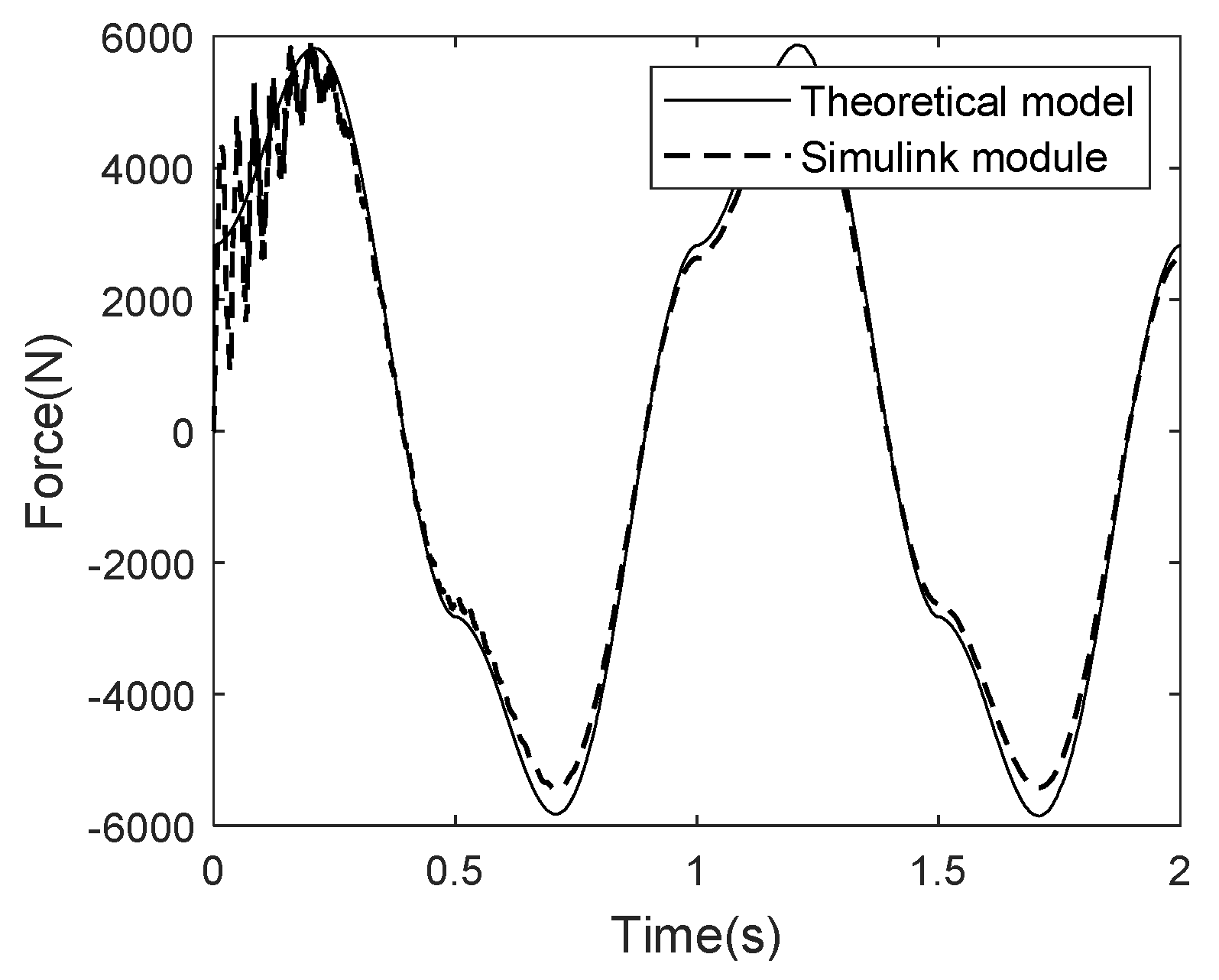

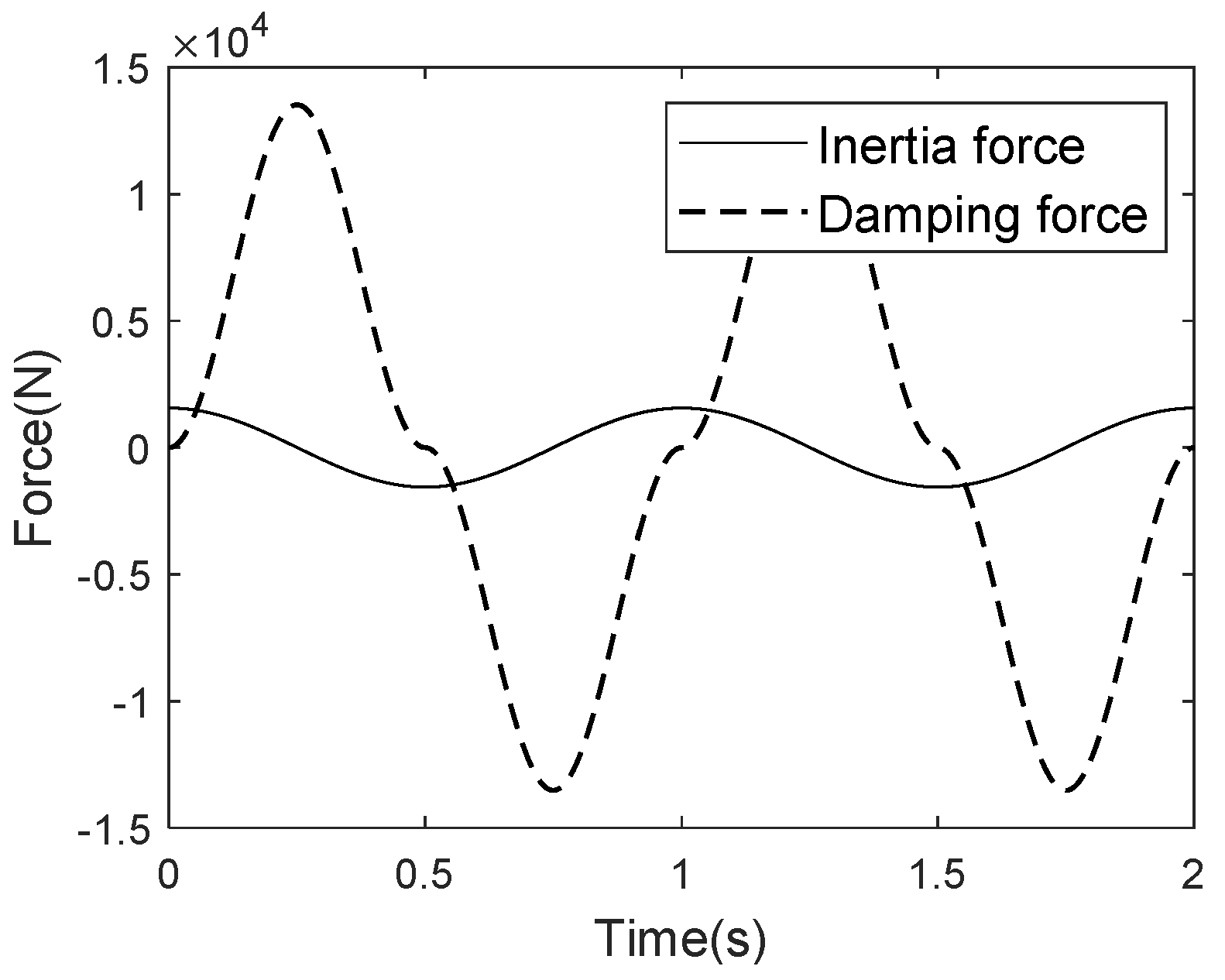

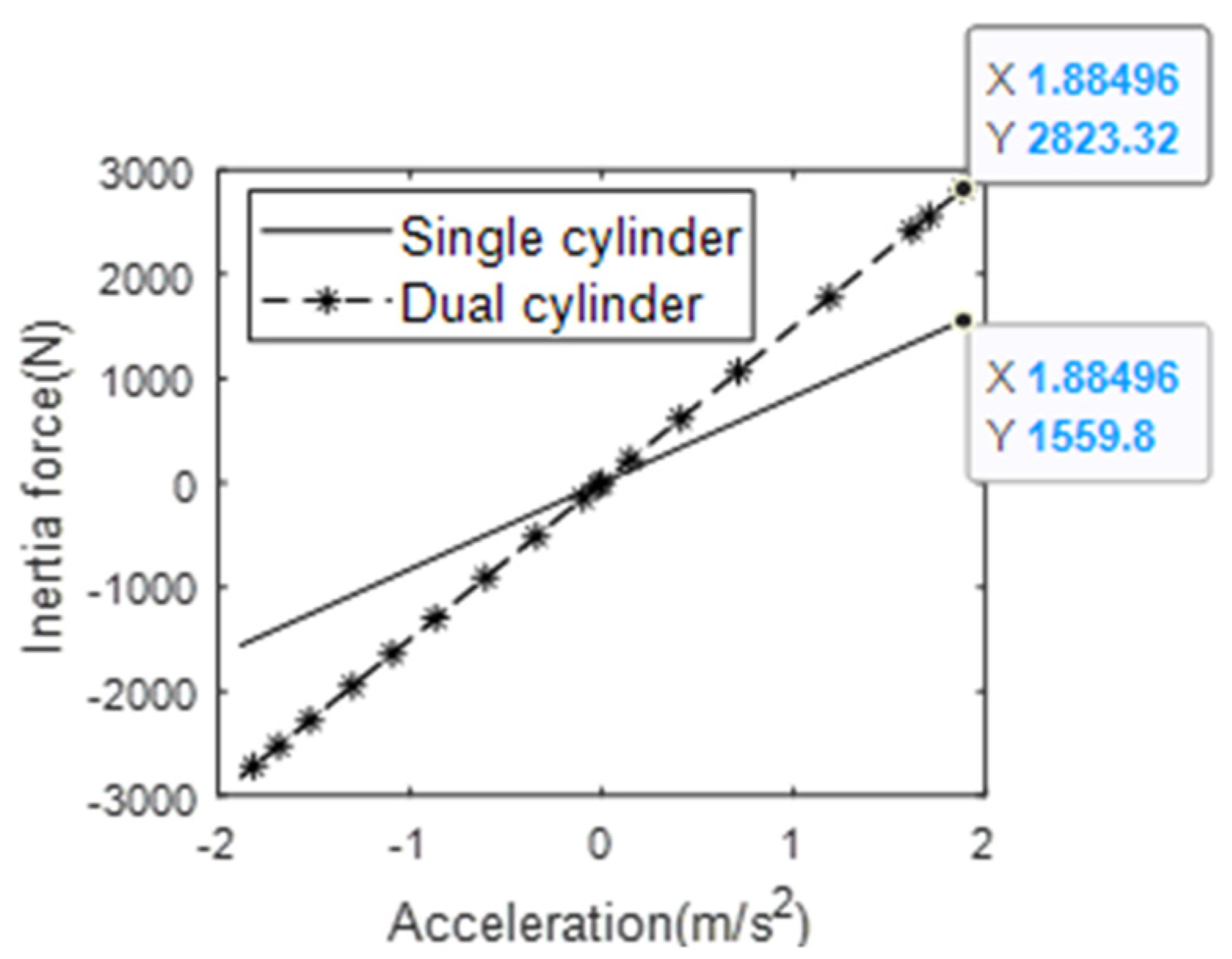
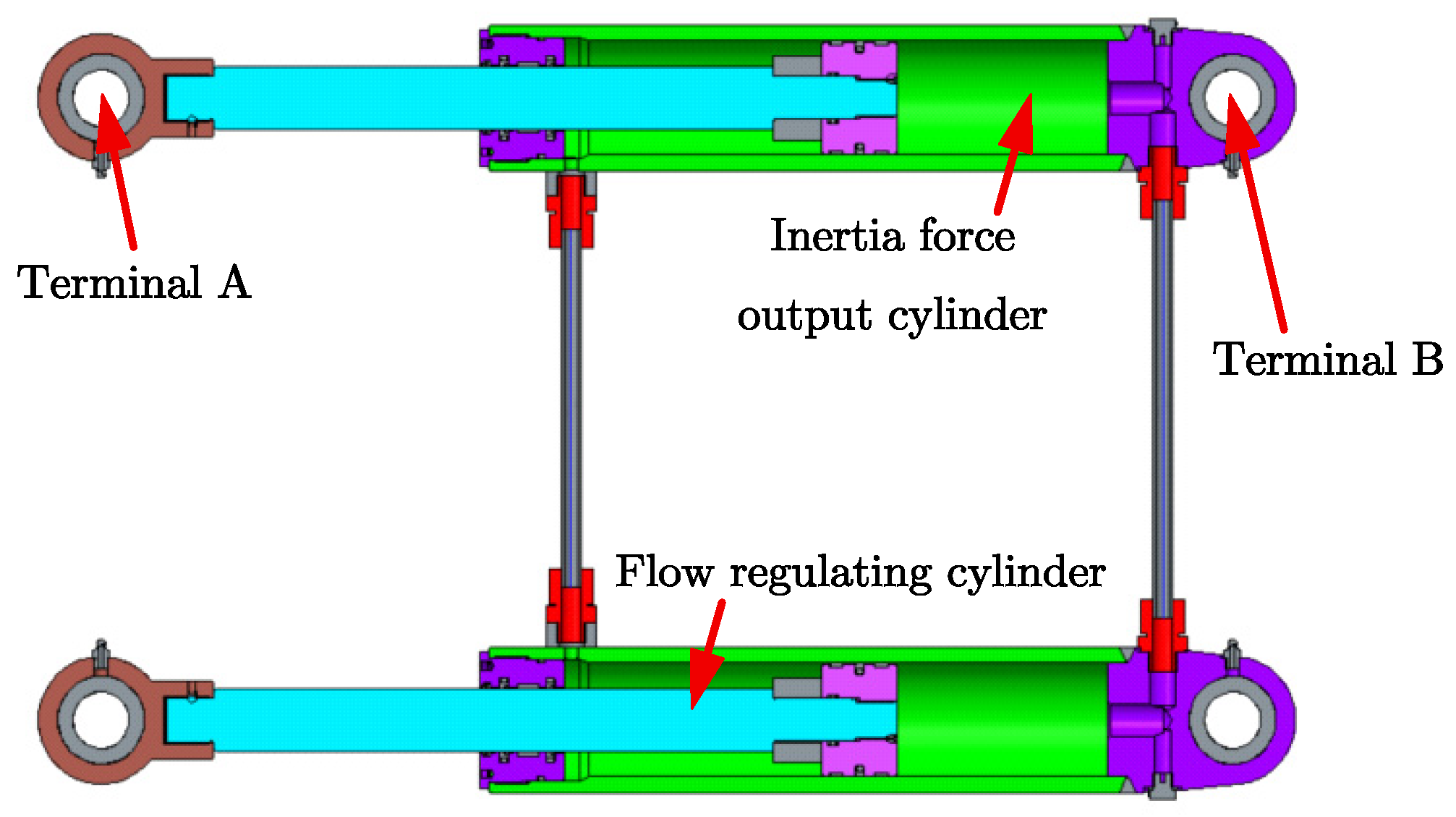


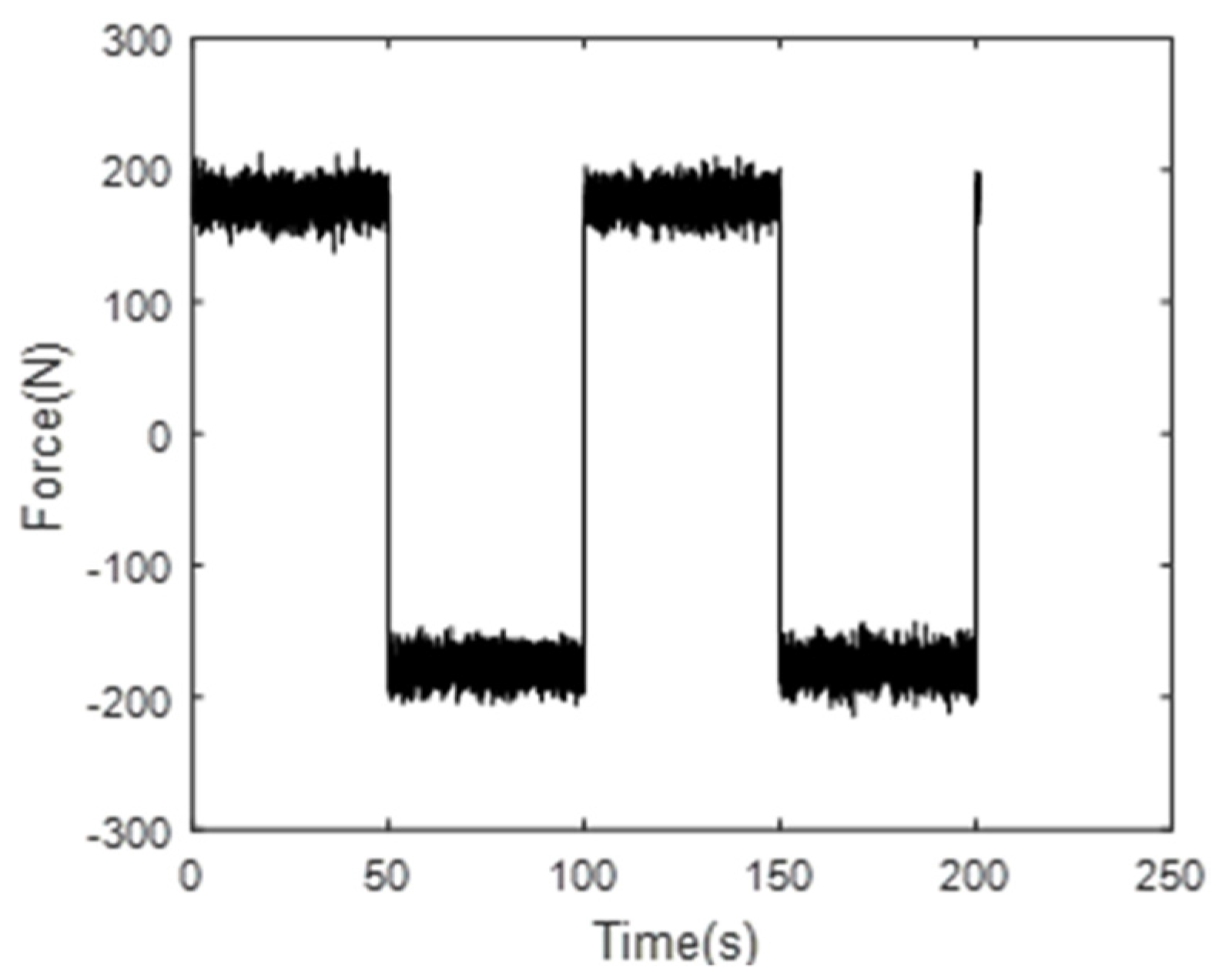
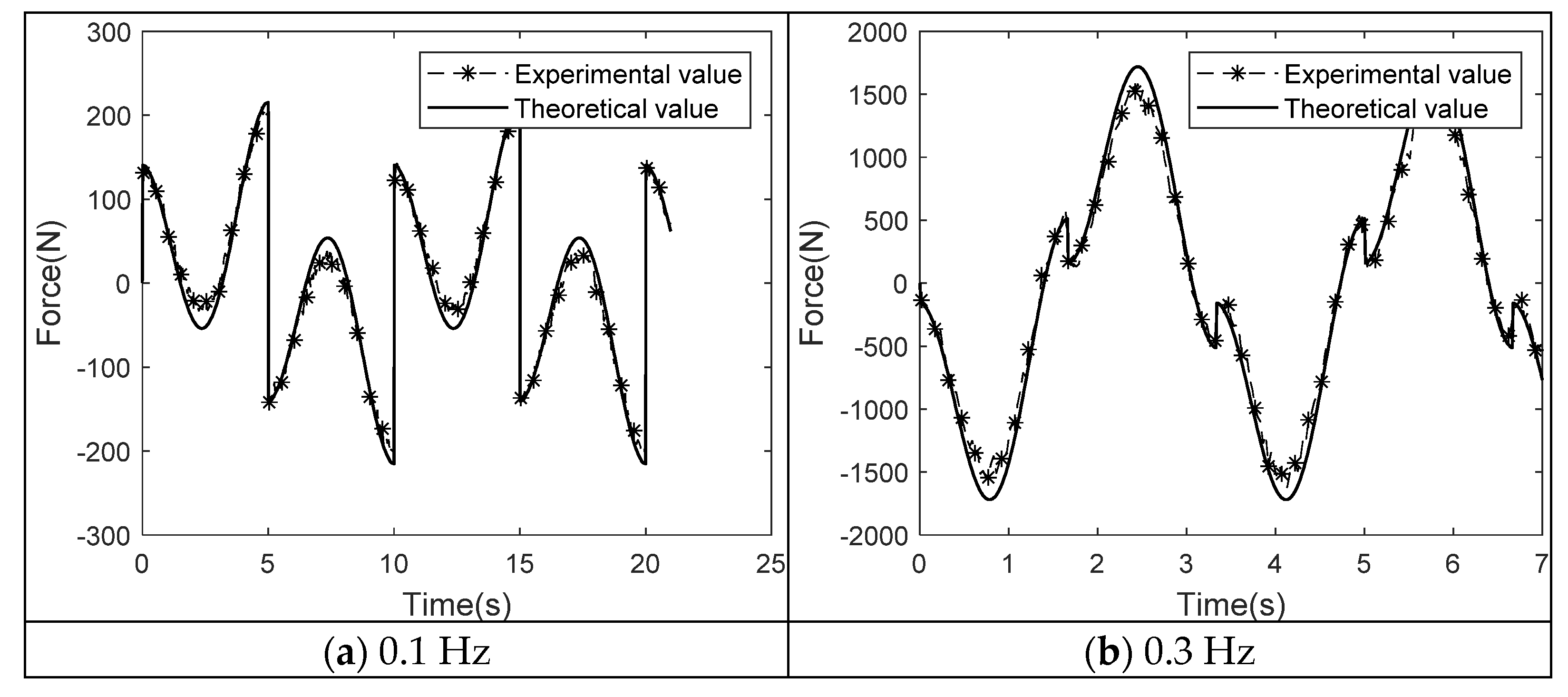
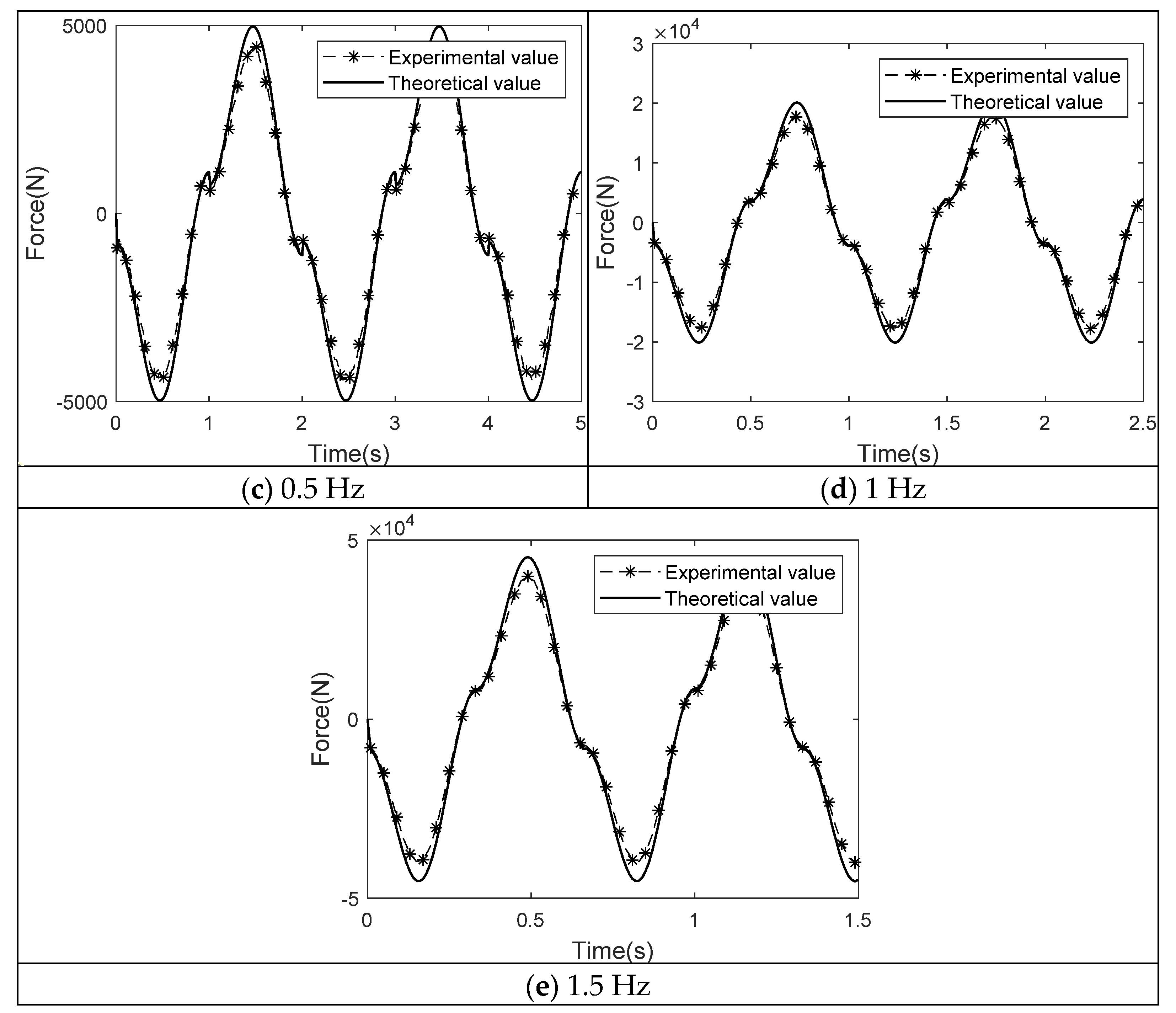
| Structure Size | |
| Diameter of main chamber cylinder 2D2(mm) | 80 |
| Diameter of main chamber cylinder 6D6(mm) | 80 |
| Diameter of piston rod 18D18(mm) | 50 |
| Diameter of piston rod 17D17(mm) | 50 |
| Diameter of pipeline 4D4(mm) | 12 |
| Diameter of pipeline 11D11(mm) | 12 |
| Length of pipeline 4L2 (mm) | 5000 |
| Length of pipeline 11L11 (mm) | 5000 |
| Parameters of the Fluid Medium | |
| Fluid type | water |
| Densityρ(kg/m3) | 1000 |
| Dynamic viscosityµ (cSt) | 1 |
| Input Signal Parameters | |
| Input type | sinusoidal velocity signal |
| Amplitude (mm) | 60 |
| Frequencyω(Hz) | 1 |
| Inertance | Result |
|---|---|
| Inertance generated by pipeline 4B4 (kg) | 1115 |
| Inertance generated by pipeline 11B11 (kg) | 412 |
| The total inertanceB(kg) | 1527 |
| Structure Size | |
|---|---|
| Diameter of cylinder (mm) | 80 |
| Diameter of piston rod (mm) | 50 |
| Diameter of pipe (mm) | 12 |
| Length of pipeline (m) | 10 |
| Parameters of the Fluid Medium | |
| Fluid type | Water |
| Densityρ(kg/m3) | 1000 |
| Dynamic viscosityµ(cst) | 1 |
| Result | |
| Inertance (kg) | 828 |
| Frequency (Hz) | Max of Experimental Value (kN) | Max of Simulation Value (kN) | Size Error (%) |
|---|---|---|---|
| 0.1 | 0.24 | 0.213 | 11.25 |
| 0.3 | 1.68 | 1.83 | 8.93 |
| 0.5 | 4.55 | 4.88 | 7.25 |
| 1 | 19.32 | 20.16 | 4.35 |
| 1.5 | 45.43 | 47.1 | 3.68 |
Publisher’s Note: MDPI stays neutral with regard to jurisdictional claims in published maps and institutional affiliations. |
© 2022 by the authors. Licensee MDPI, Basel, Switzerland. This article is an open access article distributed under the terms and conditions of the Creative Commons Attribution (CC BY) license (https://creativecommons.org/licenses/by/4.0/).
Share and Cite
Du, F.; Wang, C.; Nie, W. Modeling and Experimental Study of the Dual Cylinder Fluid Inerter. Appl. Sci. 2022, 12, 10849. https://doi.org/10.3390/app122110849
Du F, Wang C, Nie W. Modeling and Experimental Study of the Dual Cylinder Fluid Inerter. Applied Sciences. 2022; 12(21):10849. https://doi.org/10.3390/app122110849
Chicago/Turabian StyleDu, Fu, Chao Wang, and Wei Nie. 2022. "Modeling and Experimental Study of the Dual Cylinder Fluid Inerter" Applied Sciences 12, no. 21: 10849. https://doi.org/10.3390/app122110849




